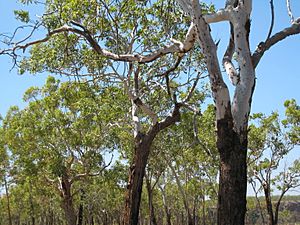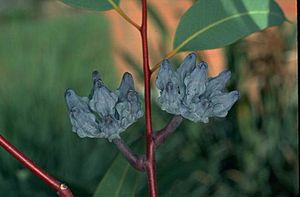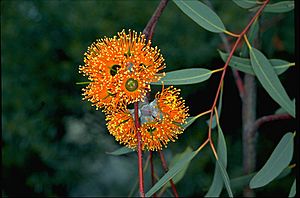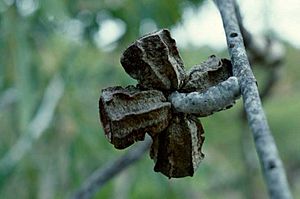Darwin woollybutt facts for kids
Quick facts for kids Darwin woollybutt |
|
|---|---|
 |
|
| Eucalyptus miniata on the Yambarran plateau, Victoria Bonaparte | |
| Scientific classification | |
| Genus: |
Eucalyptus
|
| Species: |
miniata
|
 |
|
| Occurrence data from AVH | |
| Synonyms | |
|
Eucalyptus aurantiaca F.Muell. |
|
The Darwin woollybutt (scientific name: Eucalyptus miniata) is a special type of tree that grows only in northern Australia. It is also known as the woolewoorrng by the Miriwoong people. This medium to tall tree has rough, brownish bark on its main trunk. Higher up, its branches have smooth, grey bark.
Its adult leaves look like the tip of a spear. The flower buds have ridges and grow in groups of seven. When they bloom, the flowers are a bright orange or scarlet color. After flowering, the tree produces fruit that is shaped like a cylinder, barrel, or urn, also with ribs on its sides.
Contents
What Does It Look Like?
The Darwin woollybutt usually grows to be about 15 to 25 meters (about 50 to 80 feet) tall. Some can even reach 30 meters (nearly 100 feet)! It typically has one main trunk.
Its bark is soft, rough, and has cracks. It can be grey to reddish-yellow-brown on the trunk. The bark on the upper trunk and branches is smooth and light grey.
Young plants and new shoots have greenish-brown leaves. These leaves are oval-shaped, about 3 to 6 centimeters (1 to 2.5 inches) long and 2 to 3 centimeters (about 1 inch) wide. Adult leaves are a dull or slightly shiny green, paler on the underside. They are shaped like a spear, about 7.5 to 15 centimeters (3 to 6 inches) long and 2.5 to 5 centimeters (1 to 2 inches) wide.
Flowers and Fruit
The flower buds grow in groups of seven. They are found on a stem called a peduncle, which is about 1 to 3.5 centimeters (0.4 to 1.4 inches) long. Each bud might sit directly on the stem or have a tiny stalk up to 7 millimeters long.
Mature buds are often club-shaped and have a dusty, grey-green look. They are about 1 to 2.3 centimeters (0.4 to 0.9 inches) long and 0.9 to 1.2 centimeters (0.35 to 0.5 inches) wide. They have ribs along their sides and a rounded cap.
This tree flowers from May to September. The flowers are a beautiful orange or scarlet color and can be up to 3.5 centimeters (1.4 inches) across.
The fruit are woody capsules. They are shaped like cylinders, barrels, or urns, and are quite large, about 3.3 to 6 centimeters (1.3 to 2.4 inches) long and 2 to 4 centimeters (0.8 to 1.6 inches) wide. They also have long ribs. Inside the fruit are dark grey to black seeds, about 0.5 to 0.7 centimeters (0.2 to 0.3 inches) long.
How It Got Its Name
The Darwin woollybutt was first officially described in 1843 by a botanist named Johannes Conrad Schauer. He used notes from another botanist, Allan Cunningham.
The scientific name miniata comes from Latin. It means "flame-scarlet," which perfectly describes the bright orange or scarlet color of its flowers.
The Miriwoong people, who live in the Kimberley region of Western Australia, call this tree woolewoorrng.
Where It Lives
The Darwin woollybutt is commonly found in open forests and savanna areas. It also grows on sandstone cliffs. It prefers sandy soils.
You can find this tree widely across northern Australia. It grows in the Kimberley region of Western Australia, throughout the northern parts of the Northern Territory, and even into the Burketown area of far northwestern Queensland.
Its Role in Nature
Red-tailed black cockatoos that live in northern Australia really enjoy eating the seeds and fruit of the Darwin woollybutt. It's an important food source for them!
Is It Endangered?
The Darwin woollybutt is currently classified as "not threatened" by the Western Australian Government's Department of Parks and Wildlife. This means it is not in danger of disappearing.
Images for kids
See also
 In Spanish: Eucalyptus miniata para niños
In Spanish: Eucalyptus miniata para niños






